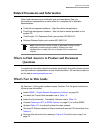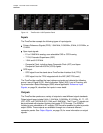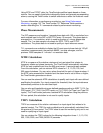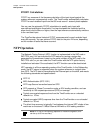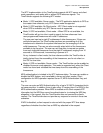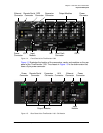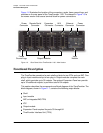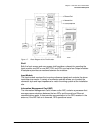
097-58001-02 Revision G – April 2008 TimeProvider User’s Guide 25
Chapter 1 Overview of the TimeProvider
Performance Monitoring
Using MTIE and FFOFF data, the TimeProvider qualifies inputs based on these
metrics. You can specify thresholds to disqualify inputs and generate corresponding
alarms, causing the TimeProvider to switch references or enter the Holdover mode.
For more information on performance monitoring, see Using Performance
Monitoring, on page 116. The TimeProvider TL1 Reference Guide contains a
section describing the TL1 commands related to performance monitoring.
Phase Measurements
The IOC measures and transfers 1-second phase data with 100 ns resolution from
each enabled input to the IMC or IMC/TPIU every 10 seconds. This phase data is
averaged to a 1 ns resolution, which is used to produce a 1-minute phase data
sample. The 1 ns data sample is the basis for MTIE, TDEV, and FFOFF
calculations. The phase data is not used to qualify an input reference source.
TL1 commands are available to display the 60 most recent phase data (at 100 pS
resolution) measurements, the previous 86400 1 ns data averages, and the
previous 10080 samples of 1-minute 1 ns-resolution data.
MTIE Calculations
MTIE is a measure of the relative noisiness of an input signal that relates to
frequency offsets and phase transients. The TimeProvider automatically calculates
MTIE for each enabled input from the 600 most recent 1-second phase updates.
From this calculation, you can retrieve MTIE values for 1, 5, 10, 50, 100, and
500-second windows. You can set an alarm threshold for each of these windows; if
the MTIE value exceeds this threshold and the alarm level is set to Minor or higher,
the TimeProvider generates an alarm.
You can use the automatic MTIE calculations to qualify each input with user-defined
qualification thresholds. If an input exceeds the threshold, then the input reference
automatically switches to the next-best input.
You can also set thresholds using pre-defined masks according to ANSI T1.101 (for
PRS inputs), ITU-T G.811 (for PRC inputs), or ITU-T G.812 (for Type I and Type II/III
inputs). The TimeProvider performs a second MTIE calculation using the previous
24-hour period; this calculation is not used to qualify inputs.
TDEV Calculations
TDEV is a measure of the relative noisiness of an input signal that relates to its
spectral content. The TDEV for each enabled input is automatically calculated from
the previous 24-hour period. The TDEV value is used for monitoring only and is not
used for qualifying an input signal.
You can retrieve the TDEV values for the following integration times: 1, 5, 10, 100,
500, 1000, 5000, and 7200 (84000/12) seconds.



